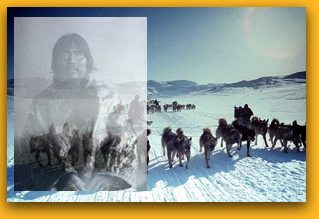
 |
 |
Inuit
Culture and |
|
POLITICAL AND HISTORICAL NEW FOOTINGS The Inuit gradually increased into the coastal zones of the Arctic in Quebec and Labrador in 1000 AD. It is believed that they were the first to encounter the Vikings. With great ambition, the Inuit drove their extension down to the Lower North Shore of the St. Lawrence to profit in trade. Even though the Inuit fished, using harpoons, along the coastal areas during the ice-free months, they never developed the capability to settle in winter on the coast. The natives followed the seal hunts, but later retreated to more sheltered forest regions, where caribou hunting was their main source of support during the winter (Michel Noel, 1997). According to the book Our Footprints Are Everywhere, written by the Labrador Inuit Association, there is a strong possibility that the meshing of the Inuit with European settlements, in turn strongly influenced by Inuit culture, were the cause of continuous business along the northern regions and in coastal regions as far south as Newfoundland and Quebec in "La Romaine." At the end of the 15th century Basque (Portuguese) and Normand Breton (French) fishermen were fishing in the Gulf of St. Lawrence. I believe they made contact with the Innuit and became quickly accustomed to trading trinkets like knives, tea and hides in the 16th and 17th centuries. It was not long after that when, at Tadoussac, Quebec, north of the Saguenay River, the Europeans established their first trading post in America. The balance of power between the First Nations and the Europeans at the time of contact (around 1638-1648) was upset when the native people chose to ally themselves with either the British or the French for socioeconomic power. In 1670 the Hudson Bay Company (HBC) was created, established on James Bay, as an enormous British commercial empire dedicated to the fur trade. The HBC created the fur trade, which expanded in New France during the 16th century, and Jesuit missionaries (among the Innu) and Moravian missionaries (among the Inuit) began to settle and convert the native people. Changes in trade practices among the Inuit occurred between 1700 and 1850 because of extensive contact with the Europeans. They were exposed to trading posts, acquiring wooden boats, rifles and iron implements for cooking European foods such as tea, flour, sugar and so on, decreasing their dependency on their own environment. By the 19th century most of the ancient Innuit ways had disappeared (Michel Noel, 1997). Rifles changed the Inuit method of hunting, harpoons became non-existent, trapping fur for the Europeans became an important source of income and socioeconomic bartering became their subsistence. Additionally, the Christianity learned from Moravian missionaries replaced their old beliefs, their way of living, dwellings and clothing. All these practices began to disappear, and assimilation occurred after the mid-1800's, as the Innuit began to rely on European manufactured goods and practice a way of life similar to the European settlers.
THE JERSEY MAN Let us go back to the late 1700's or early 1800's, to the possible history of a real man named Peter Leon. After extensive research but little luck, I called the municipality office in St. Augustin, Quebec and explained my troubles in finding out who Peter Leon really was. A few days later Nicole Driscoll called and informed me that an elderly woman named Diane Kennedy, 92, who is a descendant of the family and now resides in St. Augustin, Quebec, recalls hearing Peter Leon referred to as "The Jersey Man." At first I thought I had never heard of a Jersey man before, but as I sifted through my research files on the history of Labrador Straits, there it was! I was excited because at last there was a break-through. I believe Peter Leon was French, only because most of his family today speak French, but was exposed to the English culture because of where he came from. Therefore, I believe he was bilingual. Apparently, "Jersey" was used commonly to refer to the Channel Islands in Europe, Guernsey and Jersey. They were located near the French coast of the English Channel. The English and Jersey merchants traveled in the early 1800's by ship through the Strait of Belle Isle and established cod fishing stations along the Labrador Straits at Forteau, L'Anse au Clair, L'Anse au Loup and Blanc Sablon around 1774. Jersey rooms were referred to as fishing premises established by "Jersey men" along the Labrador Straits coast, hence his nickname "The Jersey Man." What is the history of these stations and why were they established? The French established L'Anse au Clair in the early 1700's and in 1702, according to Labrador Eskimo Settlements of the Early Contact Period, written by Garth Taylor, Augustin de Courtemanche was given permission by the King of France to establish stations all along the southeastern Labrador coast to fish for cod and seals for a period of ten years. Later he built settlements for seal fisheries at Red Bay and Riviers des Francois (Pinware River) when permission was later awarded to Pierre Constantin in 1713. He built the first French post at Grand St. Modet (today's community of West St. Modeste), producing oil from the feet of seals and salting the seal pelts for shipment to Quebec City. It was not until 1763 that France's right to fish along the Labrador coast ended. Due to the monopoly of commerce, the Treaty of Paris brought a long-waged war between the French and English to an end. Under the treaty's terms, the islands of Miquilon and St. Pierre were ceded to France (and belong to France to this day). France also maintained the right to fish along a portion of the Newfoundland coast. All other lands were given over to Britain. It was then that the Labrador coast was joined with Britain's Newfoundland colony. The following decades saw the arrival of new commercial interests in the Labrador Straits (Garth Taylor, 1974). My question, then, is in which of these communities did Peter Leon stay and where were these "Jersey Rooms" located? Apparently, there were three communities where Peter might have been employed: the L'Anse au Clair, Forteau or at Pinware River. The smallest one of the Jersey Rooms was at Anse St. Claire, later named L'Anse au Clair (St. Clair's Cove), situated on the Labrador Straits. The ruins of stone building foundations are quite visible now, along with an extensive stone paved walkway, enhanced by another lovely, secluded cove called L'Anse au Cotard, located just a few minutes walk from the Quebec-Labrador border. The other community which was occupied by French, English and native people was Forteau, meaning strong waters, a reference to strong ocean tides and currents. A Jersey merchant, De Quettville, established this particular fishing village in 1774. The Jersey and Guernsey Islanders settled in this village on the western side of the bay and at Buckle's Point, while the English group from Devonshire, England settled at English Point on the eastern side of the bay. The last possible community where Peter may have been employed was at Pinware River for the seal and salmon fishery. The lower river is wide and swift-flowing, emptying into a shallow channel at the mouth. Great for fishing, it also has a beautiful sandy beach for a stroll and a swim. So as a result did he and the other Europeans consider any problems in the takeover of Inuit land and of the fishery monopoly? A great number of European men who were engaged by these stations left Labrador at the end of the summer fishing season. Only a few remained behind, and I believe Peter Leon was one of the men who may have been engaged to take care of one of the premises or became involved in the seal fishery. At any rate, he was described as a "winter man," becoming the first year-round white settler on the Labrador Straits. In that time, traditional aspects of Innuit culture were replaced or greatly modified by the western economy, starting first from the Strait of Belle Isle to the northern coasts of Labrador. As a result, socio-economic change came about due to the centralization of food sharing and the redistribution of trade goods into the control of only a few powerful Inuit leaders. Driven by frequent attacks and embezzling by the Inuit, the Europeans tried to get on good terms with these natives, but it was clear that these peaceful trading intervals were short-term. Early documents, at around 1715, classified the Eskimos as cruel and ferocious savages who would kill Europeans if they had the chance. I feel the natives had a valid reason to attack, because they were maltreated, fired from their trade and killed by the Europeans so that the trade and fishing monopoly would be controlled only by the white society. If they attacked and killed Europeans, it was only by way of reprisal. Unfortunately, major changes in Innuit life resulted from systematic trade and contact with European establishments.
|
|